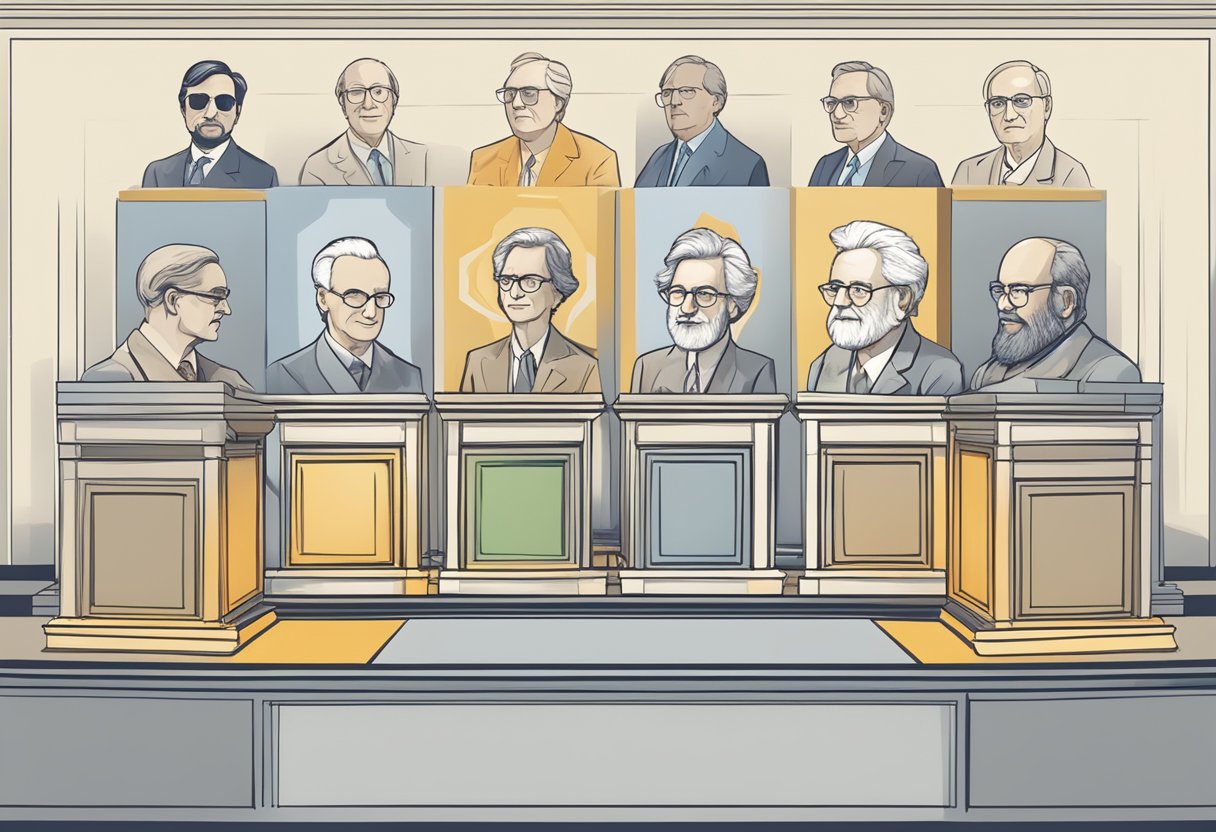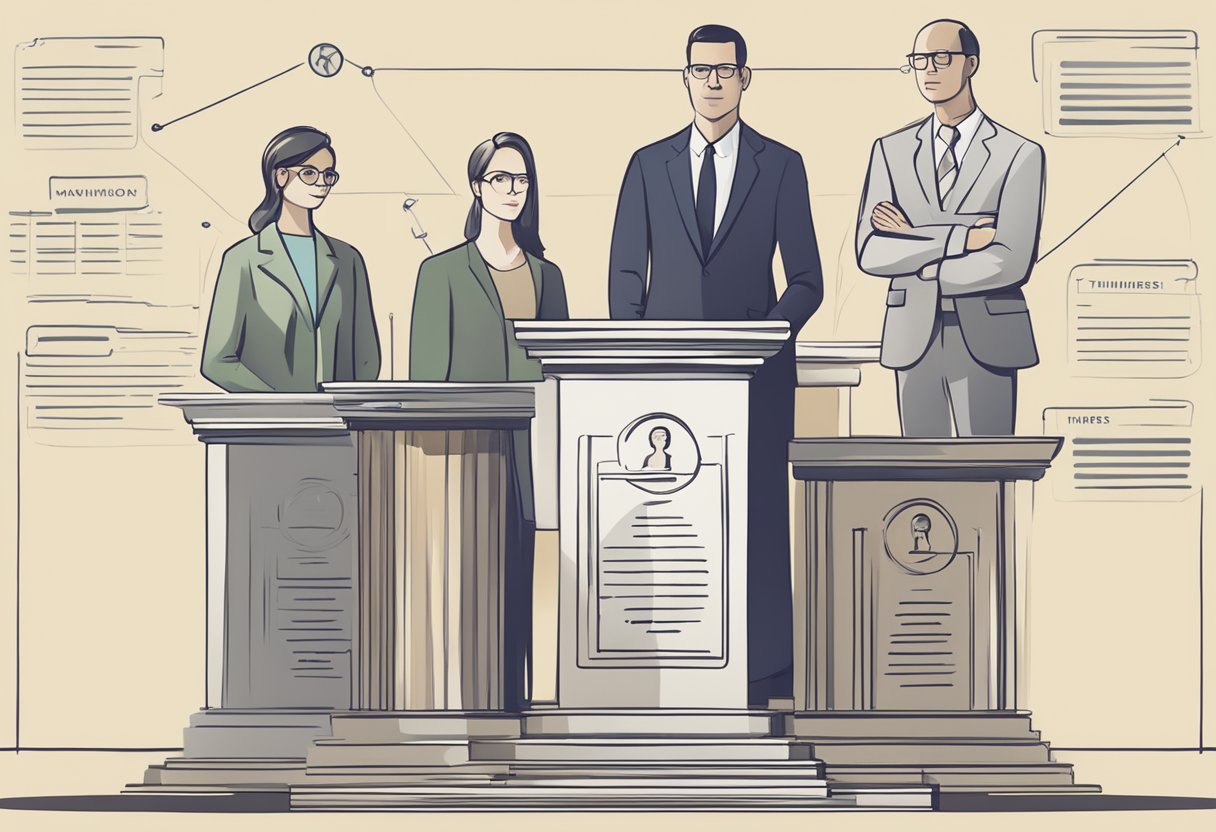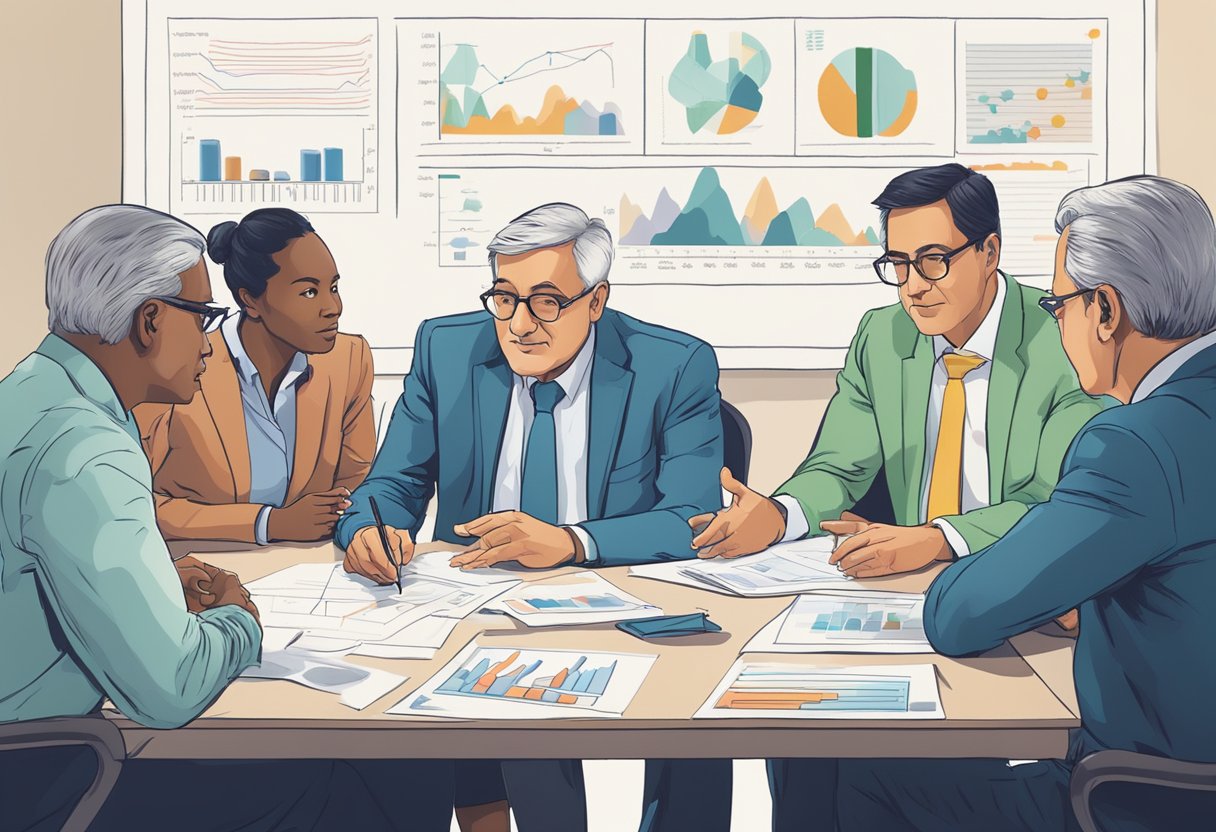The landscape of strategic thinking is ever-evolving and incredibly vital to the success of businesses and organizations around the world. Amidst a sea of intellectuals, certain individuals stand out for their innovative approaches and profound contributions to the field of strategy. These thought-leaders have not only penned influential theories but have helped shape the way organizations approach complex problems and make critical decisions. Modern-day strategic thinkers draw from a rich heritage of leadership and governance, applying analytic rigour to navigate through uncertain business terrains, which has led to substantial strategic impact within their respective fields.


To lead effectively in today’s dynamic environment, it’s crucial to understand the foundational elements that these strategists have developed. Their insights into strategic analysis and decision-making processes are instrumental in crafting and implementing successful strategies within the workplace. As we examine these prolific figures, it becomes apparent that their thinking is central to future advancements in strategic theory and practice. These thinkers not only devise strategies, but also evaluate their success, setting the benchmark for leadership in the context of globalization and digital transformation.
Key Takeaways
- Influential strategic thinkers revolutionize organizational problem-solving and decision-making.
- The development and execution of strategy rely heavily on their foundational ideas and leadership.
- They provide a template for assessing strategic success and point towards the future of strategic thinking in a globalized world.
The Foundation of Strategy


The essence of strategic thinking lies in understanding its genesis and application within the business environment, where it becomes a cornerstone for gaining a competitive edge.
Conception of Strategic Thinking
Strategic thinking originates from the ability to foresee the potential of individuals or organizations. It involves a holistic approach that integrates innovation into the fabric of decision-making. Oriented towards the long term, strategic thinking encompasses setting clear goals and envisioning a direction that steers efforts toward these objectives. It’s not limited to the upper echelons of leadership but is a mindset that can permeate an organization’s culture, fostering a shared vision for the future.
Strategic Thinking in the Business Context
In business, strategic thinking shapes the framework for planning and direction, distinguishing competitive companies in their respective industries. Firms that employ this approach can better navigate the market, leading to an advantage that is difficult for competitors to replicate. Strategic thinking transforms insights about the industry into actionable plans, carving out a niche in the business landscape that aligns with the company’s overarching vision and goals. It requires a continuous assessment of external conditions and internal capabilities, allowing businesses to adapt and evolve in a dynamic environment.
Profiles of Top Strategic Thinkers


Strategic thinkers are instrumental in driving innovation and progress across various sectors. Their ability to analyze trends, anticipate challenges, and devise effective strategies places them at the forefront of leadership and change.
Innovative Business Leaders
In the realm of business leadership, strategic thinkers stand out for their capacity to adapt and thrive in rapidly changing markets. The Thinkers50 awards, often referred to as the Oscars of management thinking, recognizes such individuals who bring transformative ideas to the corporate table. These leaders excel not only within the confines of business schools but also in the real-world application of strategic innovation, impacting both their workforce and the larger economy.
Pioneers from Diverse Industries
Strategic thinkers are not confined to one field; they emerge from various domains including technology, science, and the arts. Each pioneer brings a unique perspective to tackling industry-specific challenges. Their cross-disciplinary insights often lead to groundbreaking advancements, exemplifying their role as top thinkers in their respective industries.
Trailblazers in Economic Policy
In the sphere of economic policy, visionary leaders play a critical role in shaping responses to global challenges such as debt crises and the COVID-19 pandemic. They utilize a blend of economic acumen and political savvy to devise policies that attempt to stabilize and stimulate the economy. Such leaders contribute to both short-term recovery efforts and long-term strategic planning, ensuring resilience and growth in turbulent times.
Strategic Leadership and Governance


Strategic leadership and governance are critical for steering organizations through complex, rapidly-changing environments. Leaders must navigate challenges and leverage diverse perspectives to shape effective strategies.
Leaders’ Role in Shaping Strategy
Leaders are at the helm of developing and implementing strategic visions. They are responsible for creating balance between the long-term goals and the short-term operational needs of their organizations. For example, during the pandemic, leaders had to rapidly adapt their strategies to ensure their organizations’ survival while also preparing for future challenges.
In addition to managing action and change, they must consider diversity in leadership perspectives, including gender and cultural backgrounds, which enriches strategic decision making and increases effectiveness. Brexit, for instance, presents unique strategic challenges; leaders within affected organizations must recalibrate strategies considering new economic and political landscapes.
Effect of Political and Economic Shifts
Political and economic shifts often force an organization’s governance structures to evolve. Constitutional changes, international relations, and economic policies have profound implications that strategic leaders must address. The impact of figures such as Donald Trump on international trade and policy created a series of global economic ripples, compelling leaders worldwide to revise their strategies to maintain equilibrium.
Strategic governance, therefore, must be dynamic enough to respond to such shifts, by revising existing protocols and possibly by drafting new ones to maintain legal and ethical standards of operation. Organizations have to balance these changes while maintaining their core mission and values, ensuring that governance remains a stable foundation amidst the flux.
Strategic Analysis and Decision-Making


In the realm of strategic planning and execution, top modern-day thinkers emphasize the pivotal role of strategic analysis and robust decision-making. These processes shape an organization’s capacity to harness data, anticipate shifts, and forge partnerships to capitalize on opportunities.
Data-Driven Strategic Planning
Organizations led by strategic thinkers navigate the business landscape using data as their compass. They recognize that accurate data collection and analysis are non-negotiable skills critical for making informed assumptions. Data not only guides the strategic planning process but also informs the development of an actionable plan. The strategic decision-makers synthesize information from research, market trends, and historical analytics to pinpoint potential opportunities. By leveraging data, they can engineer strategic plans that align with their objectives and the dynamic environment they operate in.
Anticipating and Managing Change
These thinkers are adept at anticipating emergent trends and preparing for change before it arrives at their doorsteps. A well-crafted action plan includes strategies for various scenarios, ensuring that an organization can pivot in the event of an emergency or other unforeseen changes. Forecasting potential changes allows for preemptive measures and the construction of resilient structures to not only withstand shocks but also to transform them into growth opportunities. Through continuous monitoring and reassessment of strategic plans against the shifting landscape, they provide a roadmap that ensures sustained progress despite the vicissitudes of the business world.
Implementing Strategy in the Workplace
In the fast-paced business world, effective execution of strategy and fostering a culture of innovation are paramount for any organization. It is about striking the right balance between strategic planning and adaptative action, ensuring that initiatives align with the company’s goals and the workplace is agile enough to seize opportunities.
Executing Strategic Initiatives
The first step in executing strategic initiatives is to clearly articulate the goals and objectives to all stakeholders. This ensures a unified understanding of the desired outcomes and the action plans laid out for the organization. A critical challenge during implementation is maintaining this clarity in the face of day-to-day operations. Action plans need to be task-specific, and the roles and responsibilities for each team member should be distinctly outlined. Balance often comes from regular progress reviews and adaptations to the strategy as necessary, which can take the form of revised timelines, altered resource allocations, or shifted priorities based on ongoing evaluation.
Tools and Technologies:
- Project management software
- Milestone tracking
- Real-time performance dashboards
Key Strategies:
- Regular status updates
- Agile methodologies
- Employee training sessions
Embracing Innovation and Change
Creating a culture of innovation in the workplace is vital for organizations to remain competitive and relevant. It involves not just introducing new ideas but effectively integrating them into daily operations. This cultural shift generally poses a challenge as it requires a depart from traditional methods to embracing change. Businesses should encourage a culture where trying and doing new things is rewarded, and fear of failure is minimized. Opportunities for innovation can be fostered through cross-departmental collaboration and open forums for idea sharing, which often lead to unexpected and valuable insights.
Initiatives for Innovation:
- Hackathons and idea marathons
- Collaborative workspaces
- Innovation workshops
Benefits:
- Diverse problem-solving approaches
- Improved product or service offerings
- Enhanced competitive edge
Evaluating Success and Strategic Impact
In the realm of strategic thinking, success is not merely a destination but an ongoing process underpinned by clear goals and sustainable practices. Top strategic thinkers measure effectiveness not just through immediate results but also by the enduring growth they engender.
Measuring Strategic Outcomes
To accurately assess the efficacy of strategic initiatives, one must look beyond short-term accomplishments. A robust framework for evaluating strategic success entails regular reviews against well-defined goals. This involves considering the advantage garnered relative to competitors and the balance maintained among varying priorities. For instance, an organization may analyze key performance indicators (KPIs) that reflect its strategic position within the market and adapt its approaches to fortify its standing.
Long-term Vision and Sustainable Growth
The vision of strategic thinkers often transcends the present, laying the foundations for sustainable growth in an evolving economic and environmental landscape. Strategic thinkers cultivate resilience by integrating considerations like climate change into their development plans, ensuring continuity in the face of change. By pursuing a course in tune with future trends and societal shifts, entities can secure their relevance and prosperity for years to come, maintaining a resilient balance against unpredictable challenges.
The Future of Strategic Thinking
The landscape of strategic thinking is evolving rapidly, shaped by increasing innovation and the imperative for adaptability in a world driven by technological advancements. Strategic leaders are at the forefront of directing organizations towards capturing new opportunities within the future economy.
Adaptation to Technological Advancements
In the realm of strategic thinking, the adaptation to technological advancements is not just inevitable; it is essential. Organizations are continually introduced to new tools that can process vast amounts of data, predict trends, and optimize decision-making. Leaders adept at strategic thinking will harness these advancements, using platforms like Google to inform their strategies and maintain a competitive edge. As machine learning and artificial intelligence evolve, they will integrate these technologies to anticipate market shifts and drive innovation.
The Role of Strategic Leaders in Tomorrow’s Economy
The future economy will place ever-greater value on the role of strategic leaders. Their ability to navigate complex economic landscapes and adapt to change will determine an organization’s trajectory. The New York Times and similar Influence-setters underscore the growing need for leadership that can critically assess global trends, identify sustainable growth opportunities, and develop transformative strategies. Tomorrow’s economic success stories will be those led by strategic thinkers who have mastered the delicate balance between short-term gains and a long-term vision.
Frequently Asked Questions
In examining strategic thinkers who shape our modern business and innovation landscape, it’s essential to understand who these individuals are, what sets them apart, and how their influence can reshape industries.
Who are some current leaders in strategic thinking?
Leaders in strategic thinking today include CEOs, entrepreneurs, and thought leaders who have pioneered change and innovation. Elon Musk with his vision for space and renewable energy, and Sheryl Sandberg known for her role in scaling Facebook, are prominent examples.
What qualities define a strategic thinker in today’s business environment?
Strategic thinkers in today’s business environment exhibit a clear vision, analytical problem-solving capabilities, adaptability, and foresight in decision-making. MasterClass outlines characteristics like problem-solving and realistic planning as essential traits.
Which thought leaders have significantly impacted modern strategies?
Thought leaders such as Clayton Christensen, known for his theory on disruptive innovation, and Simon Sinek, with his influential concept of ‘Start With Why,’ have notably shaped modern strategic approaches.
How can one cultivate a strategy mindset incorporating the five key elements?
To cultivate a strategy mindset, individuals should focus on building skills in analysis, implementation, innovation, agility, and communication. Strategy experts emphasize the importance of balancing long-term vision with immediate actions, thereby integrating key elements into daily practice.
What are the characteristics of rare strategic thinkers in contemporary times?
Contemporary strategic thinkers possess an ability to anticipate future trends, embrace complex problem-solving, and inspire innovation. They are resourceful, resilient, and often have a global perspective on business and technology issues, as highlighted by The Knowledge Academy.
How do contemporary strategic thinkers influence business and innovation?
Strategic thinkers today profoundly impact business and innovation by driving change, inspiring novel solutions to complex problems, and fostering a culture of continuous improvement. They lead the charge in a rapidly evolving global market and are instrumental in achieving sustainable competitive advantages.





